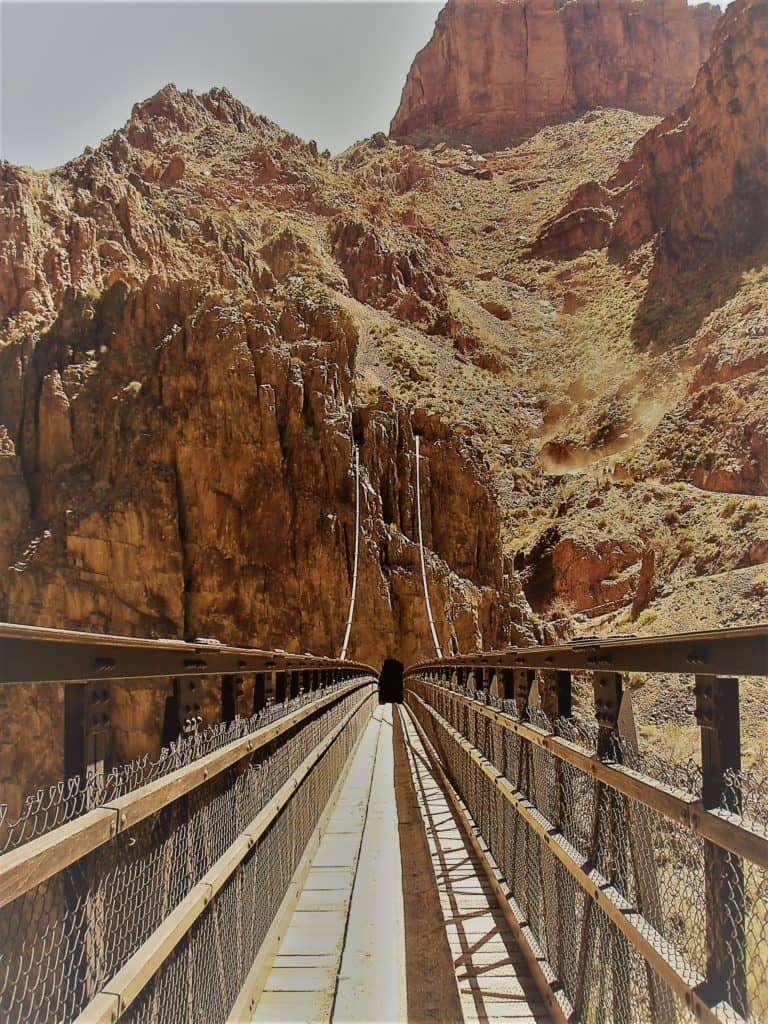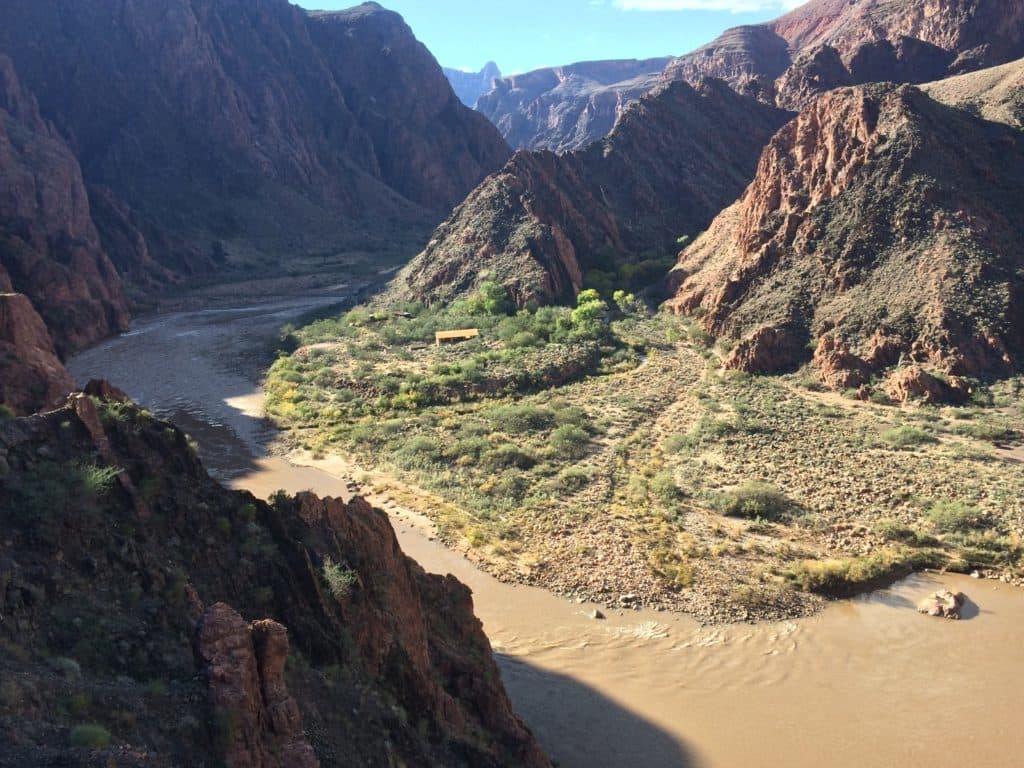Summer is ending soon, and in the months to come you’ll spend months of mentally and emotionally taxing work guiding your students in the classroom. What can you do to keep active through the fall and recharge your batteries during Thanksgiving break or next spring break? Why not consider training for a Thanksgiving Grand Canyon hike? Build your fitness and plan an amazing trip! Today’s guest blogger, Rhoda Friend, shares how she and her friend did it, and some tips for pulling off your own Grand Canyon hike. Take it away!
More...
Oldies are goodies, and this is one is about 17 million years old: The Grand Canyon. My friend Linda and I hiked there at spring break. (Linda called it our Thelma and Louise Trip. Haha! She’s such a joker.)
We started off down S. Kaibab Trail on a cold spring morning—it looked like late winter at the top. Snow covered the ground, and we took care not to slip on the icy patches on the trail. The sun was just peeping through the cathedral spires as we wound down through the switchbacks.

In the next two hours, we passed through all the seasons—winter at the top, spring about 3 miles down, summer from about mile 5 to the bottom.
We had trained thoroughly, and it was paying off handsomely. The first 5 miles were soooo easy. I had much, entirely too much, to say about our great training, and how easy the hike was. Linda gently reminded me that we were going downhill. About 7 miles from the top, we arrived at the bottom of S. Kaibab Trail, crossed the suspension bridge over the Colorado River, went through a tunnel, and stopped at the rest area just off the N. Kaibab Trail.

We ate lunch near the ancient Puebloan (previously called Anasazi) kiva ruins, rested and refilled with water. We were ready for the ascent.
We crossed the second suspension bridge to S. Bright Angel Trail, and walked along the trail—river on our right, and steep stone facing on the left, for just under 3 miles up.

Then the trail made sharp turn and started up. And up. And up. About 2 miles up, a mule train came toward us. Following rules and trail courtesy, we stepped to a wide spot in the trail.

We took advantage of the time to re-arrange our packs, change socks and put moleskin on any hot spots where blisters might form. I stepped into a small cubby in the rocks to let a mule caravan pass by. A natural ledge in the rocks provided a natural table, and I carefully laid out each item: Dates and nuts, vegan jerky, first aid kit, light jacket, sweatshirt, flashlight/headlamp. As the mule team passed by, I realized my derriere was sticking out into the trail. Fearing the temptation to nip or pinch would prove too much for one species or the other, I quickly turned, smiled and waved at the riders. That’s when I noticed they were wearing yellow rain slickers with large black letters on their backs that said “Mule Rider,” just in case someone didn’t realize they were riding a mule.
Weight nicely distributed and mule train in our rear view, we continued up the trail. Somehow, our training didn’t seem so thorough any more. Sweat soaked our tank tops, and only the bandanas we had tied around our heads kept it from pouring into our eyes.
After 4 miles of uphill, we stopped for a break. I pulled out my trail mix and heard scampering feet. Soon, four fat squirrels eagerly peered up at me, begging for a treat. Signs everywhere commanded, “DON’T FEED THE WILD ANIMALS,” but I reasoned that any animal who comes running at the sounds of a Ziploc bag opening, and sorts through the proffered handful of trail mix with a practiced eye, taking only the best nuts, is not wild.

As we started off and continued hiking, I began to be convinced we had stepped onto a treadmill. One step. Just one more step. Step. Rest. Step. Rest. Isn’t that the same mud I saw 20 minutes ago? Who moved my cheese?
Nearly 6 miles later, we arrived at the top. Victory! Celebration! We did it like the Wild Women we were. We immediately began to make plans for the next ascent—which we have done 8 more times since that day.
There are several things you need to know about hiking The Canyon. First and foremost, The Canyon is deceptive. Respect it, and respect your own physical limitations. This is not the place to try something you’ve never done before for the first time. People die at the Canyon every year. Don’t be one of them.

The Canyon is deceptive in so many ways. Here are some things to watch out for if you want to hike the Canyon:
First and foremost, The Canyon is deceptive. Respect it, and respect your own physical limitations.
- Seasons. If you hike in the spring or the fall, it will be cold at the top with snow on the ground, you will hike down through late spring, early summer and mid-summer—and it may be very hot on the bottom. The sun heats the rocks, and the heat radiates. The first time we hiked down to the river, it was 20 degrees at the top, and nearly 100 degrees at the bottom. Dress in layers—shorts and tank top for the bottom, longer pants/long sleeves/sweatshirt/jacket for the top.
- Sweat, heat and dehydration. Electrolytes: Don’t leave home without them. We carried a gallon of water each, used most of it going down, and refilled at the bottom—we used most of that going back up. I have used as many as 24 packs of Emergen-C drink with minerals to stay hydrated. Nearly every time we have hiked, we’ve had to share water with someone on the trail. Or food. I’ve had to call for emergency help for people stranded 2-3 miles down twice. Dehydration and heat stroke will creep up on you. Know the symptoms of each of these and avoid them with good hydration and frequent short breaks in the shade. Should the symptoms occur, stop and rest! Do NOT try to keep going. There is no fine for hiking at night, only for camping without a permit. You’ll be better off to do that than continue hiking in the sun. (ALWAYS pack a headlamp or flashlight with you for this purpose.) Cool down, rest, get out of the sun if you can. Wait. When you are cooled, rested, have drunk water with plenty of electrolytes, and heart rate is back to normal, proceed. . . slowly! The Grand Canyon is best hiked in spring or fall, not summer—especially if you plan to go to the bottom. The bottom is HOT even in spring and fall, and like an oven in summer.
- Downhill first, then uphill. Do not underestimate this. It can be harder than hiking a 14,000 foot mountain. (I know, I’ve done both.) The last time we hiked, we made it down the 9.2 mile S. Bright Angel Trail in 4 hours. It took nearly 8 hours to go the 6.7 miles back up S. Kaibab—and the hardest part is the last. Be sure to train well for this hike.
- Signs everywhere warn NOT to attempt an in-and-out hike the same day. There is a reason for this: Most people, even young and very fit people cannot do it. Part of the reason is the downhill first, uphill second issue. However, the top of the canyon is at 7,500 feet elevation. If you are not acclimated to altitude, you simply won’t have the red blood cells you will need to carry oxygen to your tissues at this altitude. Be aware that helicopters can carry people out who are stranded at the bottom or along the trail—for a small fee of $2000 or more. There is a fine for camping anywhere on the trail or at the bottom without a reservation. You can also be fined for creating a hazardous condition—for yourself or for rescuers. (36 CFR 2.34(a)(4)). In short: Do not attempt an in-and-out hike unless you are well-trained, accustomed to altitude and resilient to changes in temperature. Stay with the trails at the top, or only go down a short distance. Most people we have had to help were stranded about 2-3 miles down.
- Nutrition. Take light, nutrient-dense food—dates, nuts, jerky (vegan or animal)
- The Colorado River is not a swimming hole. Stay away from it. It’s not uncommon for people to get too near the edge, slip and be swept away. The current is swift, the river deep and very cold. Drowning and hypothermia are both fatal.
Be careful, be safe and enjoy your trip to one of the seven natural wonders of the world!

Rhoda Friend is a nurse practitioner and health educator who loves hiking, camping, traveling, sunflowers and thunderstorms.

